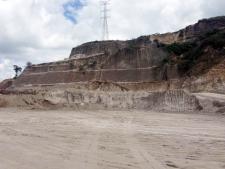Cement as a climate killer: Using industrial residues to produce carbon neutral alternatives

The basic raw material for cement is limestone, which is converted to cement clinker in large furnaces. The environmental impact of this process is disastrous: "Around one tonne of carbon dioxide is released during cement production for every tonne of limestone. The majority of this is emitted by the limestone itself," says Professor Herbert Pöllmann, a geoscientist at MLU. Replacing the limestone in cement production would result in an enormous savings potential, adds the researcher. However, the material produced would need to have the same beneficial properties as traditional cement.
In their search for alternative raw materials, the researchers from Halle came across two types of industrial waste: Residual materials from the production of kaolin and aluminium. "I don't really like the term industrial waste. It is actually industrial residues that can still be used very effectively, for example to produce alternative forms of cement," says Pöllmann. For the new study, his team tested different mixing ratios and analysed the physical properties of the newly produced cements. The study showed that the two industrial residual can be used to produce cements that have the same properties as conventional mixtures.
The advantage of the two residual materials that the mineralogists at MLU investigated is that they contain no carbon dioxide which could be released during further processing. "And you can use them to produce large quantities of cement that has great properties," explains Pöllmann. In the new study, he and his team also describe in detail the mixing ratios and production steps of the more environmentally friendly cements. According to the researcher, producers could either switch completely to the more climate-friendly materials or produce cement mixtures that use a lower ratio of limestone and are therefore also more climate-friendly.
However, the process does have its limits: "There aren’t enough industrial residues to cover the global demand for cement," says Pöllmann. Therefore, his team is also looking for suitable natural products such as volcanic ash or various mineral resources that have not yet been used industrially and that do not release carbon dioxide as well, for example various types of clay.
About the study: Galluccio S, Beirau T, Pöllmann H. Maximization of the reuse of industrial residues for the production of eco-friendly CSA-belite clinker. Construction and Building Materials (2019). doi: 10.1016/j.conbuildmat.2019.02.148




